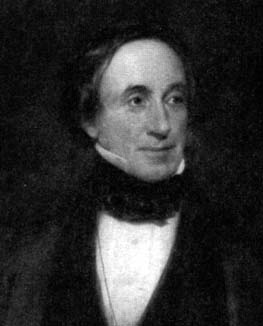
William Hopkins
 المؤلف:
R P Beckinsale
المؤلف:
R P Beckinsale
 المصدر:
Biography in Dictionary of Scientific Biography
المصدر:
Biography in Dictionary of Scientific Biography
 الجزء والصفحة:
...
الجزء والصفحة:
...
 17-7-2016
17-7-2016
 757
757
Born: 2 February 1793 in Kingston-on-Soar, Derbyshire, England
Died: 13 October 1866 in Cambridge, Cambridgeshire, England

William Hopkins's father was also named William Hopkins. Hopkins senior was a farmer, not in the sense of working on a farm but in the sense of owning a farm and employing others to do the hard work. William junior was supposed to follow in his father's footsteps so his education was not considered important. William showed little progress, particularly when he was taken to Norfolk and instructed in the practical matters concerned with the running of a farm.
Sticking with the plan that his son would become a farmer, William Hopkins senior purchased a small farm near Bury St Edmunds in Suffolk. William junior and his wife (he had by now married a Miss Braithwaite) made an unconvincing attempt to run the farm. He neither enjoyed the work nor did it bring in enough money to allow him to live a reasonable life and debts began to mount. When his wife died, Hopkins saw the chance to start a new life that he would enjoy.
Hopkins sold the small farm which his father had bought him and with the money he was able to pay off his debts. In 1822, at the age of twenty-nine, Hopkins entered Peterhouse, the oldest of the Colleges of the University of Cambridge. There he studied mathematics and, particularly when one takes into account his previous poor education, he was highly successful. He graduated in 1827 placed Seventh Wrangler in the Mathematical Tripos. This means that he was seventh in the list of those gaining first class honours in that year. Just ahead of him was De Morgan, who was in the same year and placed Fourth Wrangler in the Mathematical Tripos. Hopkins married for a second time, to Caroline Boys, while he was an undergraduate at Cambridge. They had three children, one son and two daughters.
After graduating Hopkins became a private tutor at Cambridge, having Tait, Thomson, Stokes, Maxwell and Todhunter among his pupils. He was highly successful being called the "senior wrangler maker". Rouse Ball relates that in 1849:-
[Hopkins] was able to say that he had among his pupils nearly two hundred wranglers, of whom seventeen had been senior and forty-four in one of the first three places.
A little calculation shows how remarkable these figures are. By 1849 there had only been about 20 senior wranglers during the time he tutored (there was only one top student in each year) and around sixty placed in the top three. Of course once he gained a reputation as the best tutor he was able to select the beststudents from the first year class to tutor. Some tutors concentrated entirely on examination technique but Hopkins [3]:-
... was conspicuous for encouraging in his pupils a disinterested love of their studies, instead of limiting their aspirations to examination honours.
Hopkins made relatively little contributions to pure mathematics, other than in his tutoring and with a two volume text Elements of Trigonometry written in 1833 and 1847 which contains interesting historical comments. However, he did make major contributions to the application of mathematics to geology.
He became interested in applying mathematics to geology in 1833. This came about because of his friendship with Adam Sedgwick. Sedgwick had also trained as a mathematician and had been appointed professor of geology at Cambridge in 1818. Sedgwick began fieldwork at Barmouth in north Wales in 1831 where he established the order of local rocks and gave the name Cambrian to the oldest fossiliferous strata. The name was chosen because Cambria is the old name for Wales. Hopkins accompanied Sedgwick to Barmouth on many of these trips and through this work, which he greatly enjoyed, he began to feel that geology would benefit by being put on a firm mathematical basis. He made mathematical models which won him the Wollaston Medal of the Geological Society of London in 1850.
Hopkins was President of the Geological Society of London in 1851 and 1852 (Sedgwick had been President of the Society in 1829). He was president of the British Association in 1853 when it met in Hull. In his presidential address he [3]:-
... referred to a series of important experiments which he had instituted at Manchester with the advice of Sir William Thomson and the assistance of Messrs Joule and Fairbairn, to determine the temperature of melting substances under great pressure.
The experiments were being conducted by Hopkins in his study of the interior of the Earth.
It would not be unfair to say that most of the geological theories which Hopkins proposed have turned out to be false. As Beckinsale writes [1]:-
... except in the popularisation of quantification and in the broader field of geophysics, Hopkins' effect on contemporary geology was frequently retrogressive rather than progressive. He was often lacking in geological insight ...
As to his character we refer to [3] where Anderson writes:-
He was a man of marked dignity of character and most affectionate nature. He took a keen pleasure in poetry and music, had great conversational power, and his sense of natural beauty led to his taking up, not unsuccessfully, landscape painting late in life as a recreation.
- R P Beckinsale, Biography in Dictionary of Scientific Biography (New York 1970-1990).
http://www.encyclopedia.com/doc/1G2-2830902049.html
Books:
- A D D Craik, Mr Hopkins' Men: Cambridge Reform and British Mathematics in the 19th Century (Cambridge 2007)
Articles:
- R E Anderson, William Hopkins, Dictionary of National Biography XXVII (1891), 339-340.
- W W Smyth, William Hopkins, Quarterly Journal of the Geographical Society of London 23 (1867), xxix-xxxii.
- William Hopkins, The Times (London, 16 Oct 1866), 4.
 الاكثر قراءة في 1780to1799
الاكثر قراءة في 1780to1799
 اخر الاخبار
اخر الاخبار
اخبار العتبة العباسية المقدسة


